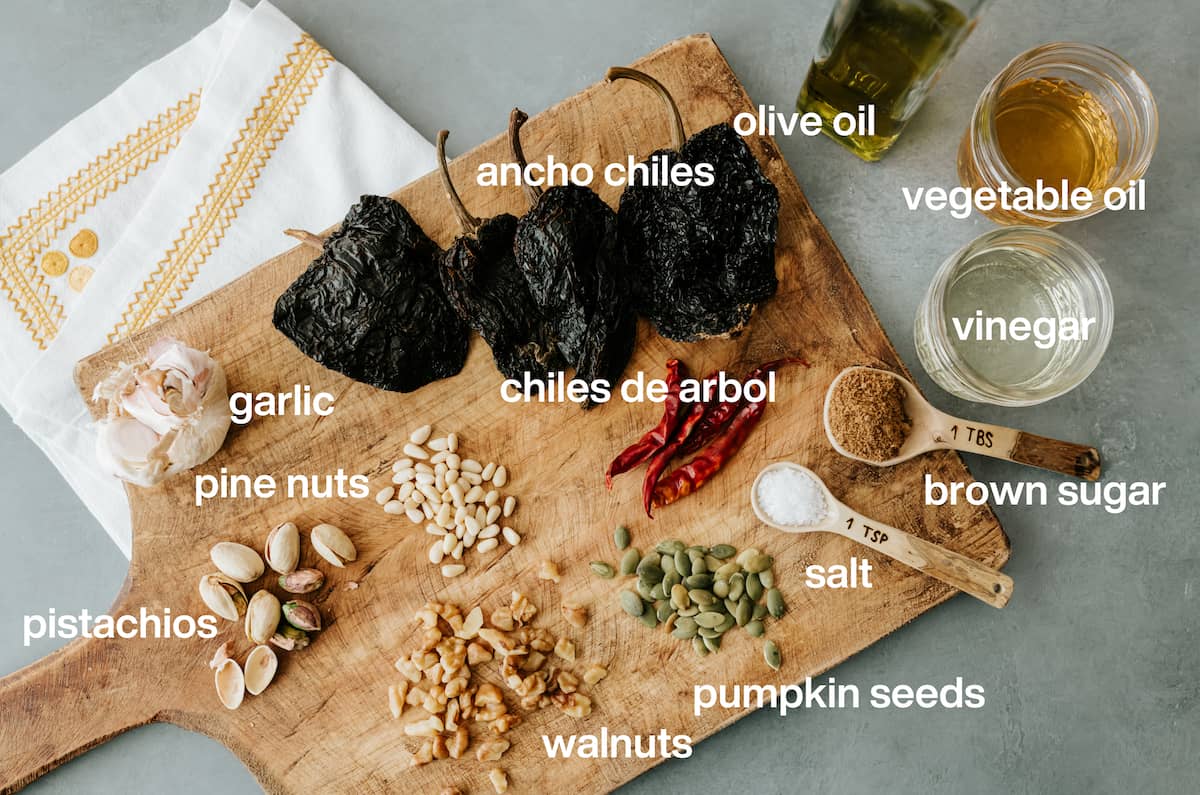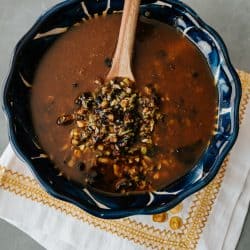Salsa Macha
If you have yet to try the magnificent Mexican condiment known as Salsa Macha, you’re about to enter a brave new world of flavor. This deeply spiced salsa is incredibly versatile, bringing a zesty bite to everything from eggs and toast to tacos and bowls.

Salsa macha is perhaps one of my greatest kitchen discoveries. This yummy condiment is at once spicy, sweet, tangy, and crunchy, making it the perfect way to add interest to any savory meal. Come learn how to make this unique sauce – it’s so easy, super customizable and will last for up to a month in your fridge!
What is Salsa Macha?
Literally translated, salsa macha means “brave sauce,” which I think is a perfect descriptor; this sauce adds an adventurous level of flavor to everything that it touches! Originating in the coastal city of Veracruz, salsa macha is the epitome of the Mexican melting pot.
Pairing old world and new world ingredients has long been part of Veracruz cuisine’s history, which is no surprise. The state – which is lined with ports – was the initial landing place for many Mexican immigrants from all over the world. These immigrants brought with them flavors of their homelands, including olive oil, garlic, and almonds.
Salsa macha is a delightful hybrid recipe that reminds me of Asian-style chile crisp sauce. Rather than relying on what we might consider salsa staples – e.g. tomatoes, tomatillos, fresh peppers, and onions – this condiment is primarily made with dried chiles, nuts, and seeds. The application is also different: rather than using as a dip for chips, this tasty sauce is used to add flavor and texture to meals.
This salsa macha recipe is from the Treasures of the Mexican Table cookbook, by Pati Jinich, New York Times bestselling author.

Ingredients & Substitutions
The ingredients for salsa macha is a crunchy flavor explosion. Feel free to swap in your own favorite combination of nuts and seeds, or use different chiles to amp up or lessen the amount of spicy heat. You can also easily change out the vinegar or sweetener according to whatever you have on hand. See recipe card below for the full recipe.
- Oil – Olive oil and vegetable oil will be needed
- Chiles – spicy chiles de árbol and chocolate-tinged anchos
- Garlic – Fresh garlic is best for this salsa
- Nuts – Peanuts are traditionally used to make salsa macha, though this recipe is made with tannic walnuts, piney pistachios, and creamy pine nuts
- Vinegar – tangy apple cider vinegar or white vinegar can be used
- Sugar – dark brown sugar or grated piloncillo
- Salt – a pinch of kosher salt will tame the tangy and sweet flavors
- Seeds – sweet pepitas and amaranth seeds. (I could not find amaranth seeds, so I omitted them)

How To Make Salsa Macha
If you still need some encouragement to make homemade salsa macha, this might make you feel better: the whole recipe takes just about 10 minutes of active work. Here’s how it’s done:
- Heat both oils in a medium skillet over medium heat.
- Add the chiles, garlic, and all the nuts and cook, stirring, until lightly toasted and fragrant, 2 to 3 minutes. Turn off the heat; add the vinegar, brown sugar, and salt, and mix.
- Stir in the pumpkin and amaranth seeds, if using. Let the mixture sit for 10 to 15 minutes.
- Scrape into the bowl of a food processor and pulse a few times until coarsely ground. The salsa will keep in an airtight container for at least a month in the refrigerator.

Serving Suggestions
Once you try a bite of this easy, smoky salsa macha, I have a feeling you’ll want to put it on everything! I’ve been dolloping it on my morning avocado toast and molletes, drizzling it on guacamole, adding it to my potato tacos, serving it alongside my grilled steaks… honestly, there’s no end to what this smoky, spicy, tangy, crunchy salsa can do!
I feel like I’ve just barely scratched the surface of what this immense flavor booster can do. Here are some of my current ways to use it:
- As a marinade for beef, chicken, or seafood.
- Served alongside grilled meats and veggies.
- Drizzled over poke or burrito bowls.
- Spooned over savory breakfasts like my Huevos a la Mexicana (Mexican Style Scrambled Eggs) or Baked Eggs with Chorizo and Potatoes.
- As a dip with chips.
- Dolloped on a bowl of soup.
Expert Tips & Tricks
- Don’t skip out on the vegetable oil. While olive oil has the better flavor, adding vegetable oil increases the smoke point of the mixture, which helps ensure that you don’t burn your salsa.
- Do not overcook the chiles as it will make for a bitter salsa.
- Wear gloves when removing seeds from the chiles to prevent your fingers from burning. Alternatively, wash your hands immediately and refrain from touching your face.
Storage Instructions
- Fridge – Refrigerate in glass jars or container for up to 1 month. This salsa is oil-based, so it will thicken in the fridge. Allow it to sit on the counter for a few minutes so the oil can soften and stir before serving.
- Freeze – Freeze for up to 3 months in freezer-safe plastic containers.

Recommended Equipment
Frequently Asked Questions
Nope! This recipe has a bit of heat, but I would place it in the “medium” category of salsas. Feel free to swap out your peppers for a more or less intense heat! This guide to Mexican chiles is a great place to find what you’re looking for.
Sure! Simply swap in your favorite seeds in place of the nuts here – sunflower seeds, sesame seeds and pepitas are all good options.
I personally am a fan of texture, so I prefer to keep my salsa macha relatively chunky. That said, this is your salsa, so do with it as you please. I have seen salsa macha that is chunky or blended into more of a pesto consistency.
Traditionally speaking, salsa macha is made with peanuts. That said, I love the combination of walnuts, pine nuts and pistachios that Pati’s recipe calls for. You can also switch things up and use any other kinds of nuts that you prefer, including but not limited to cashews, macadamia nuts, almonds, or brazil nuts.
Not to be confused with the Japanese green tea powder, macha is the feminine inflection of the word “macho.” Macha can also be interpreted to mean “brave.” Since salsa simply means sauce, salsa macha can therefore be translated to “brave (or macho) sauce.”
More Easy Salsa Recipes

Salsa Macha
Ingredients
- 1 cup olive oil
- 1/2 cup vegetable oil
- 5 dried ancho chiles, stemmed, seeded, and cut with scissors into small pieces
- 4 to 5 dried chiles de arbol, stems removed (keep seeds), cut into small pieces
- 6 garlic cloves, sliced
- 1/3 cup unsalted walnuts
- 1/3 cup raw unsalted pistachios
- 1/3 cup raw unsalted pine nuts
- 1/4 cup apple cider vinegar
- 1 tablespoon dark brown sugar or grated piloncillo, or to taste
- 2 teaspoons kosher salt, or to taste
- 1/3 cup hulled raw pumpkin seeds
- 1/3 cup amaranth seeds, (optional)
Instructions
- Heat both oils in a medium skillet over mediums heat. Add the chiles, garlic, and all the nuts and cook stirring, until lightly toasted and fragrant, 2 to 3 minutes.
- Turn off the heat, add the vinegar, brown sugar, and salt, and mix.
- Stir in the pumpkin and amaranth seeds, if using.
- Let the mixture sit for 10 to 15 minutes. Scrape into the bowl of a food processor and pulse a few times until coarsely ground.
- The salsa will keep, highly covered, for at least a month in the refrigerator.
Notes
- Do not overcook the chiles as it will make for a bitter salsa.
- Wear gloves when removing seeds from the chiles to prevent your fingers from burning. Alternatively, wash your hands immediately and refrain from touching your face.
- Refrigerate in glass jars or container for up to 1 month. This salsa is oil-based, so it will thicken in the fridge. Allow it to sit on the counter for a few minutes so the oil can soften and stir before serving.
- Freeze for up to 3 months in freezer-safe plastic containers.
Photography by Jenna Sparks
Originally published: January 2022. This recipe is published in Treasures of the Mexican Table.
 Muy Bueno: Fiestas
Muy Bueno: Fiestas 


4 Comments on “Salsa Macha”
Good for hangovers!
I keep a bag of pepitas in my freezer and can’t wait to try the salsa macha;
Could you or some of your readers please help me?
Could this salsa be preserved for longer shelf life by using a water bath and or pressure canning? If so, would you need to change in any way the way it is prepared? Love all of your recipes. Thank you so much for your help.
I went a really conservative on the Chile de árbol. What’s the best way to get one or two back in it? Also, does it freeze well?